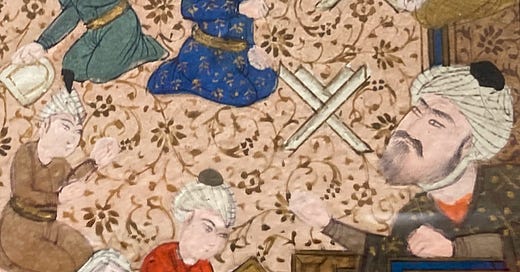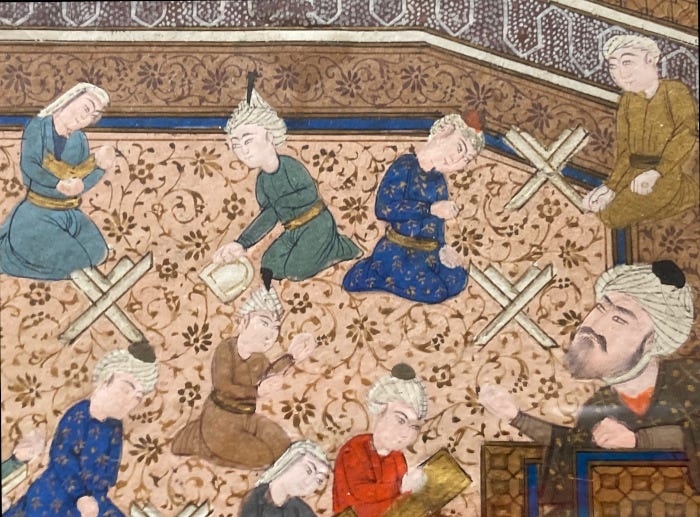Once, in a Christian town, I was invited with some friends to the home of the wife of a high-ranking diplomat from an Islamic country. It was a pleasant affair, because l don’t let myself be blinded by the powerful and wealthy. And, because I’ve taught Islamic Art, we had a friendly conversation about Islamic Art and Culture. As we were leaving, my new-found friend beckoned me into her bedroom, and if you think what I think you’re thinking—the exotic Harem Scene—stop it, or I’ll have Edward Saïd on your ass. The walls of her bedroom were covered floor to ceiling with images—some quite old and valuable—of the Prophet Muhammad.
I feel sorry for that instructor who recently got fired for showing an image of the Prophet to his class: a student ratted, a Black Muslim. I feel sorry, but not angry, let alone outraged, as some have been, and certainly not surprised. I was once fired by NYU for using the word “Karl Marx” excessively in class; so I read a book called How to be a Marxist Teacher or something like that, and its lesson has stayed with me since: If you want a revolution in the classroom keep the Marxism to yourself, otherwise you’ll get fired and you won’t have any class to revolutionize. But if you want to make a point of demonstrating to the world that you’re a Marxist, that Marxists are oppressed, and that so-called Freedom of Expression doesn’t count for them, by all means go and get yourself fired. That’s what our instructor did, minus Marxism, plus Theology.
I’ve taught Islamic Art as an Art historian, and to a class of which three quarters or more were Black Muslims, and it would never have occurred to me to show an image of the Prophet. It would never have occurred to me not to show images of human beings either, because there is no way to teach Islamic Art without bringing up the topic of the relative prohibition against images of living things, and how it applies, and when it applies, and to whom and besides, I assume any student who objects to viewing representations of the human body in general is not going to sign up for an Art History class to begin with. The human body, as Nietzsche said, is not something you can theorize away. Neither, for that matter, can you dismiss the emotions associated with it.
On the other hand, I can teach Islamic Art without once showing an image of the Prophet and still convey the belief that got our friend fired: “I would like to remind you there is no one, monothetic Islamic culture.”
Most historians of Islamic Art agree that Islamic Art is not necessarily art produced by Muslims, it’s art produced by Christians, Jews, Muslims and none-of-the-above in an environment predominantly Muslim. There is a continuum in the level of strict adherence to Islam; this must be taken into account in any class. Denial of that continuum falsifies the narrative.
None of which requires me to show an image of the Prophet. Suppose I wanted to discuss the tensions within various Muslim communities around representations of the Prophet; I would show images in which the face has been painted over, or deliberately scratched out, or had a veil painted over it, after the fact or not. If the aim is to demonstrate that “there is no one, monothetic Islamic culture,” then it’s conveyed far better ways than by showing the face itself. Showing the face suggests that this was not seen as problematic, when it was: why else would this representation be reserved for royalty and wealthy patrons for whom alone these manuscripts were painted? If the aim is to show the continuum between Islamic thought and non-Islamic influences and beliefs, I would direct my students instead to the survival of Roman and Hellenistic models of the body and of draperies which can be found in the same image used by this instructor, and in similar images, sans Prophet. Such exercises are more subtly subversive than loudly pointing out the representation of the Prophet, because they suggest Islam is permeated throughout with non-Islamic influences and manners, down to the draperies, and what’s worse, that religious beliefs themselves are porous. I’m just as likely to be fired from a Christian college like the one that fired our friend if I publicly suggest that all religions are interchangeable, and that there is no such thing as a monothetic religion to begin with.
The great anarchist thinker Paul Goodman, in a classic essay on Academic Freedom, pointed out the fundamental fallacy in liberal fantasies of Free Speech: nobody gets fired from a university for indulging in a little theoretical hanky-panky on the side: Marxist hanky-panky, theological hanky-panky, etc. When you get into trouble it’s for flaunting your favorite brand of hanky-panky as a belief, a moral calling, like a Marxist who seems to believe in it, or a deist or agnostic who insists on standing his ground. Or our friend, who somehow felt it was his calling—not his job, his calling—to show his contempt for the monothetic, a little Salman Rushdie without the bennies. Goodman goes on to tell the story of Henry Dunster, the first president of Harvard, who resigned his post because he could not, and would not, continue to teach while holding a conviction that ran against the religious convictions of the college administration, some snoozer about infant baptism. The difference between Dunster’s experience and mine or the instructor’s, is that Dunster was offered the privilege to remain; he was the college president after all.1
Because ultimately it’s all about the privilege. That’s the reason why these images of the Prophet were displayed in luxury manuscripts for the private delectation of rulers only. It’s the reason my ambassadress had these pictures up and, as an honor, wished to share her privilege: she was treating me like an equal, another privileged Muslim like herself, not like an unbeliever who didn’t give a shit. And there’s a reason why our friend was removed: excessive zeal; acting above her pay grade; and we all know what an instructor’s pay grade is.
The other difference between then and now, is that Dunster jumped before he was pushed. The similarity, is that our friend had the audacity (more likely the naïveté) to give a shit.
Paul Goodman, “The Freedom to be Academic,” Growing up Absurd. Problems of Youth in the Organized Society (New York: Random House, 1960), pp. 256-279.





Art historian calls image a "masterpiece."
Shia scholar says it's okay to show an image of the Prophet.
Cows say "moo."
https://www.nytimes.com/2023/01/08/us/hamline-university-islam-prophet-muhammad.html